I would also like to thank Katerina Liapi and Ramon Sastre for their comments and help in completing this thesis. I would also like to thank Marios Fokas, Stavros Vergopoulos, Ana Cocho Bemerjo and of course Chris Williams for being part of my defense exam.
INTRODUCTION
- Introduction to the problem
- Aims and Objectives
- Literature and Background Review
- Methodology
- PhD Structure
Furthermore, another goal is to develop adequate design methods and explore the mechanisms that will accommodate the shape-finding procedure for the irregular lattice structures. The first section gives a detailed overview of the theoretical framework and tries to draw connections with the key concepts in the PhD thesis topic of interest.
ARCHITECTURE THROUGH THE SPECTRUM OF COMPLEX
An introduction to the age of information and technology
A "digital culture" has emerged as a consequence of the ubiquitous presence and development of IT together with the introduction of computers. The notion of "algorithm" and algorithmic design ultimately changes this symbiotic relationship and describes a conceptual evolution that constitutes a new thought of design and practice, forming a kind of "new materiality" in the field of architecture.
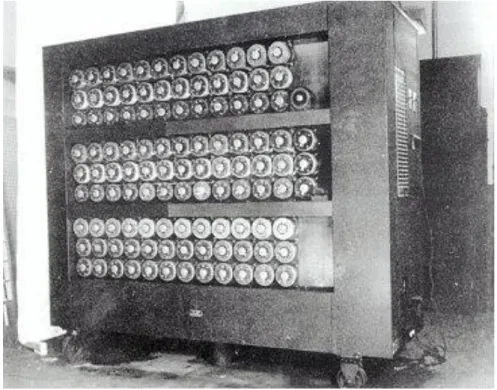
Complexity, “matter” and dynamical systems as concepts towards the
The second terminology is Material/Structural Complexity and aims to demonstrate how the idea of complexity in general and in computational design in particular is observed in an architectural and structural context. This idea draws connections and creates relationships between the concept of complexity and its application to computational design problems.
Complexity and architecture
He attributes the complexity to the idea of diversity and sophistication as a result of the program, which thus developed the so-called complex building11. All these revolutionary new ideas that transform the idea of geometric analysis form in architecture, such as the explanation of the geometric system through nonlinear dynamics, the display of structural complexity and the placement of the non-standard architectural object, are intended to be. fully developed in the following chapters.
From Nonlinear Dynamics to a Dynamical Topological system
In particular, Newton was interested in solving the "two-body problem" - the calculation between two objects, the movement of the first when orbiting the other (eg Earth-Sun). A planet's orbit is an ellipse with the Sun at one of its two foci.

From material to structural complexity: A cross-related system
In fact, before the advent of computers, most structures were discretized in two principal directions (x, y) and solved linearly, providing acceptable approximate solutions. It is a very important parameter and part of the architectural concept, which acts as a kind of candidate.

Non-standard architecture, the Non-Euclidean object problem
In architecture, however, it was first coined with Frederic Migayro 33 in an attempt to define architecturally the ongoing establishment of the "non-standard" paradigm in modern architecture. Thus, they mark the emergence of a “new paradigm” where the “non-standard” is re-established by the organic and contemporary architecture being reoriented by biological and computational essences (Mennan, 2008).
A “new Materiality” emerging in Computational Architecture
On the contrary, this new model, the "animated form", simultaneously considers the presence of force and vector in the perception of form. In the book "Digital Tectonics" he presents this trend based on several research examples in the architectural field.

NATURAL CONSTRUCTIONS INFORMING ARCHITECTURE
Towards a “Biological paradigm” in architecture
Natural structures are therefore a compelling paradigm for architects guiding and presenting certain fundamental processes observed in nature and using a variety of conceptual tools for design. Frei Otto specifically states that: “When we talk about natural constructions, we are not so much concerned with specific examples of the infinite variety of possible objects, but rather with that which is typical. We are concerned with those constructions that demonstrate with particular clarity the physical, biological and technical processes to which objects give rise.
Self-organisation as a process of design influence
Its microsystem's porous cell size and organization must be able to adapt to intense athletic activities, movement and load transmissions, thus becoming denser in the areas where conditions, such as high loads and load direction, presuppose and less dense where the loads are low (homoeostasis ). A small change or reduction in the porous of the structural system of the bones can carry damage in the strength of the system and break in its continuity, such as in the case of osteoporosis where. At the same time, they adapt to environmental changes and try to preserve themselves by making genetic changes in the characteristics of their following generations50.

Biological Constructions and Closest Packing
Microstructures such as that of the bone's inner structural arrangement presented previously and almost the majority of the materials' microstructures that compose their inner state themselves are included in a category called "cellular solids". Nevertheless, their structure varies from a very ordered, like the hexagonal honeycomb, to absolutely disordered, like the three-dimensional sponge networks. Unlike the man-made foams that exhibit more regularity in their cell size distribution using shapes such as the triangle, the square and hexagon, natural foams present greater variation in their cell size and distribution.

UNSTRUCTURED GRIDS AND STRUCTURAL COMPLEXITY
Towards a Design strategy
However, there are still many computational difficulties in the structural design of special structures (and in structural design in general). Therefore, one of the challenges presented by the digital age is the creation of an integral building, a Total Architecture, as defined by Arup, an architecture that uses the interoperability of sciences in the design process, such as architecture, structure, construction, production, services, assembly, etc. Another major challenge is to incorporate more automation into the design process, for example in the form of automated optimization.
Tessellation, transverse systems, and unstructured grids in
These names were adopted according to the properties of the space in which they are included. In order to generate a valid Voronoi diagram, the initial point distributions are first tested for the validity of the Delaunay condition. Depending on the distribution of the initial set of points, we can see that Voronoi can give rise to several different expressions of Voronoi diagrams.
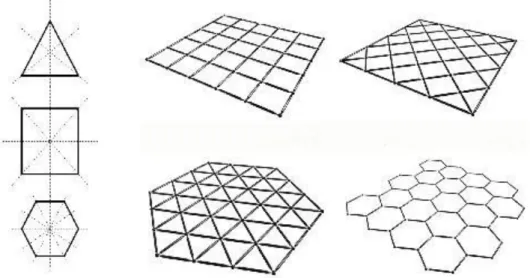
AN INSIGHT INTO GRID AND TRANSVERSE GRIDS IN
Introduction
Crystal Palace, London
After the invention of the cast glass method in 1848, the Crystal Palace became one of the largest.

Schukov Tower, Moscow
66 This type of form was also self-supporting and a first attempt to generate the first lightweight structures of the period.
Antonio Gaudi and Catenary Arches
At the time, Gaudi was not yet familiar with the theory and work of D'Arcy Thompson, he introduced rational geometry into the process of architectural planning and used a revolutionary approach to the relationship between form and structure. Obviously, there are a considerable number of people in the coming years who have been on the edge of this awareness of this structurally oriented architectural design and have used empirical techniques that, in addition to the structural validity of the initial architectural design, can also re-create the design itself. His innovations arose from the methods he used to obtain more complex and free-form surfaces, and they can be briefly numbered into the following three: the free-form hill, the pressurized membrane, and the inverted hanging fabric.

Frei Otto, material systems and Innovations in Gridshells
Most of the machines are made of materials that can assimilate forces through transformation, which is a prime example of analog computing. Nevertheless, we will make a further analysis and presentation of his research on biological constructions that fostered new structural patterns (foam, cancellous bones) as well as the suspended chain mesh models that were inspirational for the development and generation of multiple lattice shells. Since the advent of the computer in design and engineering was still of limited use, analog computing was a method for engineers to test and simulate the capacity of structures on given.

Dynamic Relaxation and Smithsonian Institute roof example
The whole system oscillates around the equilibrium position of the joints under the influence of loads. Second, the entire density of foam bubbles had to be reduced in number, resulting in an approximate 35%. Since it was transformed, the total length of the array becomes larger than the original one.

The Eden Project, Grimshaw Architects
Honey Morphologies and Hexagonal Tessellated wall structure,
Dragonfly, Technicolor Bloom and other types of irregular tessellated
Although it appears to be a complex subdivision pattern, the pattern of Clark subdivision, which gives an atmosphere of essence and aesthetics to the visitor, this prototype expands its architectural possibilities. The title Technicolor is based on the technicolor film process with visual intensity of the three primary colors. In addition to pattern variations, a number of techniques were used to multiply the effective qualities of the patterned surface.
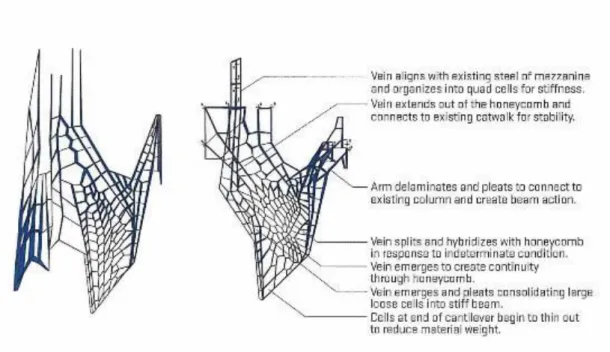
STRUCTURAL ANALYSIS OF GRID CONFIGURATIONS
An insight into the behaviour of two-dimensional and three-
There are numerous space configurations of intersecting grid systems in the bibliography, which in turn behave structurally differently depending on the applied load. However, in the case of more complex configurations, we can observe lattice systems that show resilience and offer better structural performance. In the case of the later case, the structural system, mainly prefabricated, the bar members are subjected to a combination of bending, shear and axial tension and compression forces.

Rigidity of grid systems and the act of resilience
The breaking moment in each of these reactions is clearly related to the material properties, which in this case are the properties of steel, and can be shown in the strain-stress curve. To ascertain the stiffness of a network structure, Maxwell's equation or Fopp's Principle79 must be satisfied, which is a function related to the number of rods and nodes. However, considering the previous equation, several combinations of polyhedrons can be observed, depending on the number of links and rods and on the mesh or plate structure, respectively, as shown in the figure (Figure 52).

Buckling effects and bending moments
It can be observed how important the shape of the tessellation is in relation to the stability of the grid system. The internal reaction loads in a cross-section of the structural element can be decomposed into a resultant force and a resultant torque80. This is a form of structural failure of an element, causing a complete loss of its load-bearing capacity.
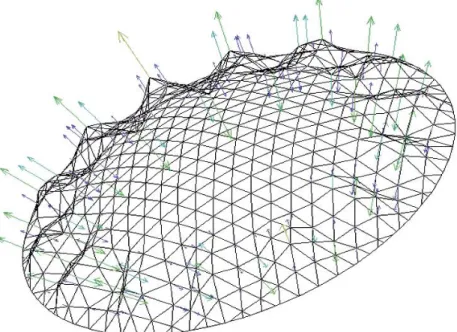
FROM SELF-ORGANISATIONAL SYSTEMS TO
- Optimisation
- Form-finding
- Structural Optimisation
- Evolutionary algorithms, the case of Genetic Algorithms
The first includes the classical form finding (or analogous form finding), which mainly concerns the definition of the structural form and supports the principle. Shape optimization has variables that act on the geometry of the structures, without changing the topology. 88 To meet the objectives of this PhD, the optimization process followed to proceed with shape finding is possible with a combination of sizing optimization and topology optimization using global methods, such as Genetic Algorithms (GA) and Simulated Annealing (SA ).

CASE STUDIES
Introduction
Determination and investigation of specific geometric shapes that are representative paradigms of self-supporting structures with identified dynamic behavior as well as load-bearing properties. This PhD thesis focuses in particular on the irregular lattice systems that are bio-inspired from natural structural patterns and have quite recently been deciphered with mathematical expressions. In addition, a brief presentation of the digital tools as well as the calculation techniques and methods used during the methodology is developed.
Previous Relevant Research
Both of them took a rectangular volume of prescribed dimensions as the initial sample model, which had to be covered with Voronoi cells. In addition, limitations had to be accepted on the estimated geometry as it was narrowed down to a single and prescribed volume. Fewer generations than expected were required to reach convergence, which at the same time resulted in very interesting complex morphologies.
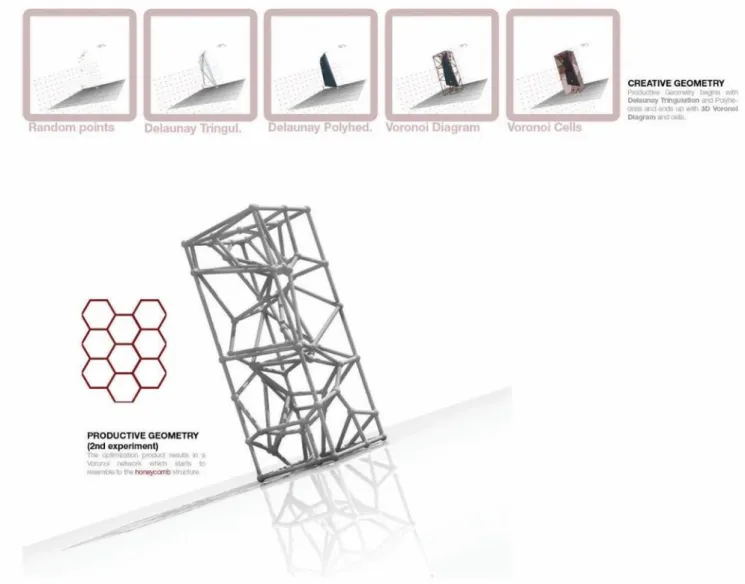
Preparatory and Generative process
- Grid Generation and parametricism
- Evaluating computationally a structural model
- Computing self-organisation and optimisation
- Defining the optimisation Goal-Fitness Function
This component is an AssembleModel as shown in the image below (Figure 73) where four (4) pieces of data are required. Another is the fitness function, which is described in more detail in the next chapter. Fitness functions are therefore represented in the form of mathematical functions or equations, depending on the number of objectives.

Pilot Study Implementation
This network is then translated into a structural model as analyzed in the previous paragraphs. This model requires the indication of nodes (Pts), longitudinal steel members (Elem), current loading condition (Load) and support locations (Support). Regarding the current loading condition, it was chosen by default to apply a random lateral load to the top of the structure, as illustrated in the previous figure.

Structurally self-organized grids via genetic algorithms on an NURBS
- Introduction to the investigation parameters
- Manheim Multihalle: background and inspiration
- Random NURBS geometry establishment and tessellation
- Experiment implementations
- Self-organisation and Structural Optimisation Parameters
- Analysis and Aggregate Results
Structurally self-organized grid morphologies via genetic algorithms on
- Introduction
- Geometrical features and background on the design of high-rise
- Self-organisation and Structural Optimisation Parameters
- Analysis and Aggregate Results
Material-based, self-organized Grid Morphologies via Genetic
- Introduction to general parameters
- First simulation: The case of Wood
- Second simulation: The case of Steel
- Third simulation: The case of Aluminium
- Fourth simulation: The case of Concrete
- Analysis and Aggregate results
APPENDIX A
TABLE OF FIGURES
PUBLICATIONS